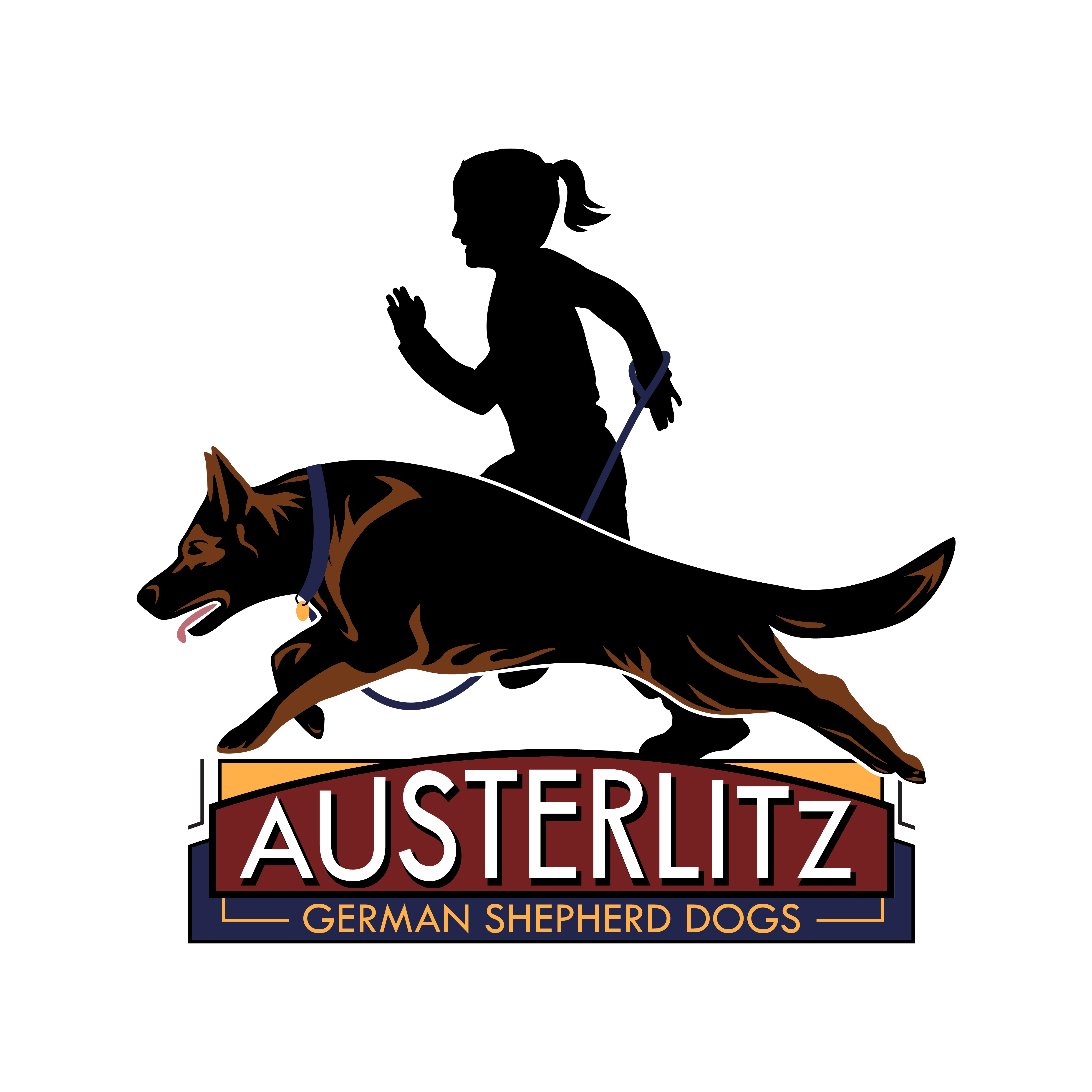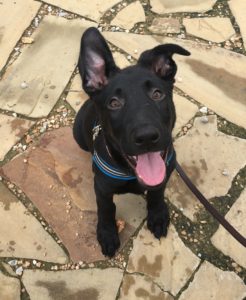Visit any Facebook group on dog care or training and you’ll find lots of questions from new puppy families. Many of these questions and concerns stem from, or are caused by, transition stress.
Stress is often defined as a state of mental or emotional strain or tension resulting from adverse or very demanding circumstances. In our case, the stress is the transition from the breeder’s home to the home of the new family. Coping with this transition should always fall under “demanding” and never “adverse” experiences, as our puppies are moving into loving and attentive homes that are carefully chosen to be just the right match for our puppy and the family.
It’s important to note that stress is beneficial for our puppy. All dogs will experience multiple stress inducing events throughout life. Indeed many dogs, such as show, sport, or working dogs, will be exposed regularly to stress and their body and mind must learn to cope and function optimally under it’s effects. In short, stress builds stronger and more resilient dogs.
Learning to cope with, and work through, stress associated with changes stems from a puppy feeling competent and confident during transitions and is an important part of the socialization experience for every dog.
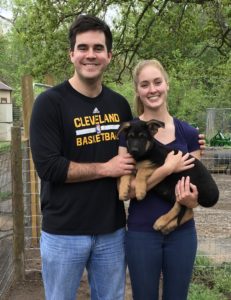
By thinking about the imminent departure of our puppy and preparing the puppy for this experience, we can help our puppy adapt as easily as possible during this transition. We can also teach our family how to help their dog master transitions, something that sets both puppy and family up for long term success.
I’ve compiled a list of 10 easy to implement exercises we use to help puppies transition smoothly to their new homes. These are based heavily on the Puppy Culture protocols we are already using.
1. Puppy will learn to anticipate transitions as positive experiences that lead to good things.
2. Family will learn how to teach their puppy that transitions are positive experiences using primary reinforcements such as: Social Interaction, Food, Play.
3. Family will learn to make the most of management and choice funnels to set their puppy up for success and growing confidence in choice.
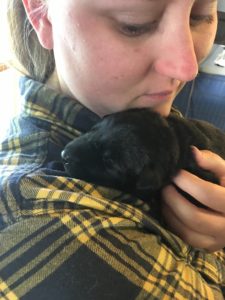
1. Individual Handling = Attention, Treats, Fun.
As per the Puppy Culture protocol we follow, as soon as your dam will tolerate it, remove each puppy from the dam and litter for individual attention. Make some time for this each day if possible. Early on, this will be exclusively cuddling, brushing, and other form of petting, but as the puppy matures and becomes socially aware this should expand to include grooming, husbandry, and training, all taught and conditioned with high value food, as well as various types of play. Create a checklist, or use the Puppy Culture Workbook to ensure you rotate through each type of activity with each puppy. Try to avoid only removing puppies for things the puppy might experience as unpleasant, such as vaccinations, worming, or other necessary care. Our goal is our puppy learning to associate removal from it’s litter with positive experiences.

2. Novel Locations = Attention, Treats, Fun.
As part of your Individual Handling, be sure to rotate through different locations. It’s tempting to simply remove a puppy and work in the living room, but make an effort to use every puppy safe room of your house, and even carrying a puppy outside to a front or back porch. Older puppies can be taken to your puppy safe yard, or even off property in a puppy stroller. If you are doing car conditioning, this counts as a novel location and individual attention too.
3. Novel People=Attention, Treats, Fun.

Even though breeders often wait to introduce novel people until puppies are older, most breeders have a small group of family and close friends who drop by to visit puppies (using all appropriate bio hazard protocols.) These visits should contain some individual handling of puppies (of course, be sure your dam will tolerate this) and use proper management and safety protocols to ensure everyone is comfortable and safe. Once puppies are in the Critical Socialization Period, visits increase. Emphasis should be placed on creating and maintaining a Positive Emotional Response or Positive Conditioned Emotional Response to people and locations.
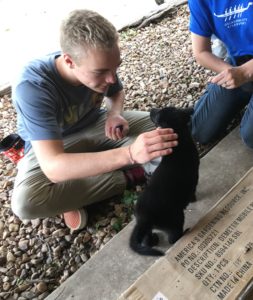
*NOTE! Always supervise and manage socialization of your puppies. Remember, Single Event Learning is real and any scary or traumatic experience during the CSP can have long lasting effects on the puppy’s behavior.
4. Create Security in Schedules.
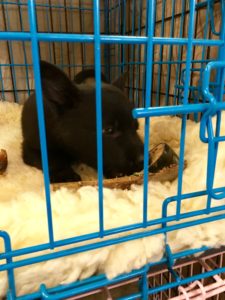
Puppies are a schedule intensive creature. By making note of your puppy care schedule, you can help both your new family and the puppy. Make note of your typical feeding/cleaning schedule as well as your training and crate conditioning routines.
Most puppies will have owners who work during the day and many puppies can expect to be confined at some point during the day, and crated during sleeping hours.
Knowing this, we try to work on crate conditioning with our litters during the day. This is fit in after morning clean up, breakfast, and play time, when the puppies are getting tired and ready for rest. At this point we do crate chews and naps, as the puppies are primed and set up for success – napping and being calm in their crates.
By anticipating what your puppy’s schedule will likely be in the new home, you can prepare your puppy for it’s transition. Knowing what to expect builds a puppy’s confidence during the stress of transition. Further, knowing this routine can help our family during the transition period, so be sure to send home a copy of your schedule with each puppy.
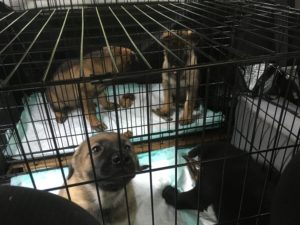
5. Create Adaptability By Throwing Out The Schedule!
We don’t want our puppy to be so habituated to a particular schedule that changes in routine are distressing. So while puppies really do require some scheduling of meals and cleanliness for their health and well being, we can also create an happy anticipation of change by pairing random events with very enjoyable activities.
Mix up your elective activities. We can’t really just “not feed or clean up after” our puppies, that’s a given. Puppies require regular feeding and a clean environment. But all other activities (passive enrichment, active enrichment, crate conditioning, etc.) are elective activities that we can move around. Since our puppies LOVE these elective activities (as they are paired with food, play, and learning) we can also create an happy anticipation of change by creating some randomness in these activities.
This is how I do this! I assign each activity a number.
1. Passive Enrichment: Novel item(s), Weaning Pen toy resets.
2. Active Enrichment: Clicker training lessons.
3. Puppy Scent Games: Puppy tracking.
4. Noodling: Yard exploration and play.
5. Crate Conditioning: Crate chews, in house or car.
6. Nothing Time: Puppies are left alone in the house.
7. Play: Fetch, flirt, tug games.
8. Nothing Time: We are home, but not interacting.
9. Grooming: Individual, one-on-one attention.
10. Active Enrichment: Clicker Training (this is twice, because we have lots of training to do!)
Then I download a free Random Number Generator onto my phone (from the App Store or Google Play) and set it from 1-10.
The Random Number Generator then gives me an elective activity, and I do this activity during one of three free times: After Breakfast, After Lunch, or After Dinner. Since I know I can’t skip feeding or cleaning up after my puppies, this means I need to work variety in between these non elective scheduled tasks. This allows me to condition the puppies to both feel confident their needs will be met. But at the same time, that many fun and unexpected things are going to happen in any day.
Note, I’ve included two types of “alone time” time, one when we leave the house and another when we are home but not interacting with the puppies. Both happen as part of our regular schedule, but I want to ensure that the puppies have lots of experience with us leaving the house, as well as us being home but ignoring the them. This mirrors real life and what will happen in any type of home situation.
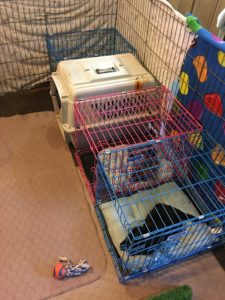
6. Invest in Crate Conditioning and teach new owners how to continue this work:
One of the greatest gifts you can give your puppy and it’s future family is investing in creating a Positive Conditioned Emotional Response to being both crated and confined in an x pen. Both are tools your puppy family needs to use to manage their puppy’s behavior and safety in the first months of it’s life, and both are a common cause of distress for puppies and owners.
Conversely, if your puppy has had rushed and forced confinement, and thus has a Negative Conditioned Emotional Response to confinement, this may express itself during transition stress as excessive vocalization, panic, refusal to enter the crate, or urinating/defecating when confined. All these signs of distress can affect outcomes in the new home and even the dog’s behavior going forward.
Be sure to teach your new puppy owners how to continue your crate conditioning work once they bring their puppy home. Here is our blog post on creating Confident Craters, a Guide for New Puppy Owners
You can find our Crate Conditioning for breeders and fosters here:
Crate Conditioning for Puppies: An incremental approach (UPDATE 2019)
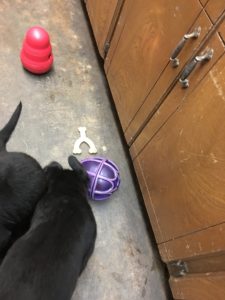
7. Teach puppies how to use pacifiers:
Your puppy’s new family will benefit greatly by being able to provide the puppy with a variety of pacifiers, but only if puppies leave the breeder knowing the behaviors needed to enjoy pacifiers this will be much easier. Again, when presented with a familiar challenge in the new home, a puppy’s feeling of competence during transition increases.
Some of these pacifiers will be instinctively engaging to puppies. Natural chews such as hooves, bones, tracheas, and bully sticks require no “teaching” and puppies will enjoy them right from the start. Some pacifiers, such as Kibble Nibbles or Wobblers, need practice and puppies need regular exposure to learn to enjoy them.
By starting around weaning age and offering different pacifiers throughout the weeks, the puppies have lots of opportunity to learn how to engage with these items and to enjoy them.
Here is a list of items we find work well for our puppies.
1. Lick mats
2. Snuffle mats (We send a snuffle mat home with each puppy.)
3. Kibble Nibble
4. Kong Quest and Wobbler
5. IQ Ball
6. Stuffed Hooves, Kongs, Trachea, Whimzee
7. Slow Feed Bowls (great for raw or canned foods!)
8. Scent Items and Familiars.
Be sure to send a scented item home with each puppy; this can be a baby blanket, fleece toy, or even the puppy’s own crate. By planning to send scented items home with the puppy, you provide a source of familiarity and comfort during transition. I love these hand crafted blanket and tug kits from Smiling Dog. Conversely, you can send home a snuffle mat, which doubles as an enrichment item and a familiar.
9. Send home detailed dietary instructions.
This is an easy one, and something most breeders do anyway. By providing detailed dietary instructions, at least a weeks supply of the breeder’s diet, and instructions for training bait and treats, the breeder can help ensure that the transition time isn’t complicated by unnecessary gastric upset. Puppies with GI upset may not sleep through the night, they may soil their crate or themselves, and all these things can push a puppy from transition stress into transition distress.
Set your families up for success by guiding them on the importance of dietary consistency in both meals, enrichment, and training bait during transition.

10. Install positively conditioned bridges to help your puppy “over” life’s transitions.
I’ve saved the most important for last. Really, this subject warranted it’s own lengthy blog (but don’t worry, I’ll save that for another day!) because it’s really just THAT important.
What do we mean by a bridge behavior? A bridge is a behavior taught in such a way that a positive emotional response is PART of the behavior. A bridge doesn’t work if it’s a behavior the puppy learned through avoidance. We want our bridge behaviors to help us reach our goal of a dog who thrives under stress, and who enjoys life’s transitions.
The magic of the bridge is in the communication between the puppy and the new owner. When puppies leave our home they also leave behind all those contextual cues and paths to access reinforcements that help them know what is expected when, and what behavior might work in particular settings. They feel a bit like “strangers in a strange land” in the new home. The new family often feels the same way, just how do they get the puppy to do the things they need? Our bridge behaviors give the puppy a way to communicate to the owner, and the owner to the puppy. There is empowerment, confidence, and mutual bonding in this shared language.
We encourage our new families to start the day they bring their puppy home with the Puppy Culture Communication Trinity, and to run through these lessons in order. Running through these familiar lessons helps the puppy feel confident and competent in the new home.
Our bridge behaviors MUST include a positive emotional response. Since we are Puppy Culture breeders and clicker trainers, this is easy for us, as all our Puppy Culture Active Enrichment Behaviors and our other clicker trained behaviors fit this requirement.
Here are the bridge behaviors our puppies are taught before they go home.
1. Sit (Mand) for things you want.
2. Attention (eye contact.)
3. Follow Leash Pressure.
4. Hand Target (touch your nose to my hand.)
5. Crate Up (enter your crate.)
6. Find It (find food I’ve tossed.)
7. Come when called.
With this small set of baby behaviors our puppy can, when unsure what to do, be quickly prompted for behaviors they are confident in and have a positive emotional response to.
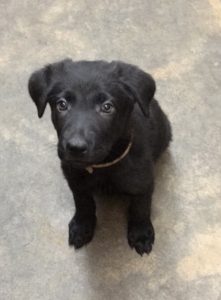
Of course, we also need to teach our new families the basics clicker training, and most importantly when and how to use the bridge behaviors.
Here are some examples of using bridge behaviors during transition week.
First Day:
Puppy can Mand to leave crate.
Puppy can Mand for meals.
Puppy can have the clicker powered up.
Puppy can Mand for toy toss.
Puppy can give Attention for tugging.
Puppy can Mand for petting.
Puppy can run outside the door to “find it”.
Puppy can Come for meals, attention, and play.
Second Day:
Puppy can Mand to leave Crate.
Puppy can Mand for meals.
Puppy can play The Box Game.
Puppy can practice Leash Walking.
Puppy can Mand for petting.
Puppy can give Attention for toy toss.
At Vet:
Puppy can Mand for social interaction.
Puppy can play Attention while vet listens to heart.
Puppy can follow a Hand Target onto scale.
Because we have already conditioned these bridge behaviors, AND taught the puppy owner how to teach, use, and reinforce them, the puppy can experience these situations (all of which are transitions) as fun and reinforcing events because the puppy “knows” how to earn reinforcement in the form of praise, food, and play. What a great confidence booster!
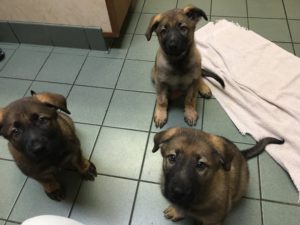
This helps our puppy learn from the very start that it has control over what happens to it, that good things are plentiful and easy to access, and that change predicts these wonderful things.
Will our puppy still experience stress during it’s transition?
Of course our puppy is still going to experience transition stress, and this stress is beneficial. But by planning ahead we can create a confident puppy who transitions easily, one who welcomes change, variety, and thinks clearly under stress.
We also provide our new puppy families with the knowledge and skills they need to have the smoothest transition possible. After all, puppies are TONS of hard work, as breeders we can lighten this workload on our new families tremendously, just through planning and execution of some good common sense protocols.
Modern dogs face many challenges and stressors that our breed’s foundation dogs and our breed architects couldn’t imagine. Modern breeders are not only producing dogs who can adapt to modern environments, but we are also doing our best to give puppies the tools they need to succeed, from the couch to the podium, right from the start.
